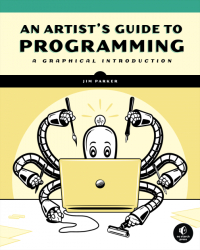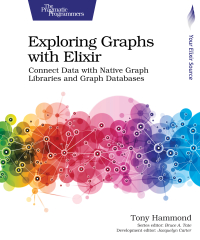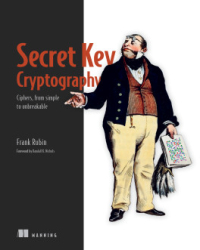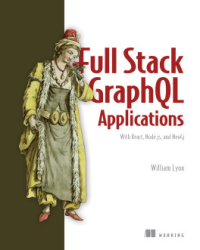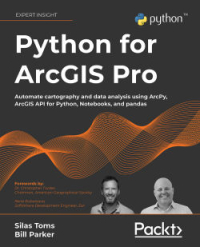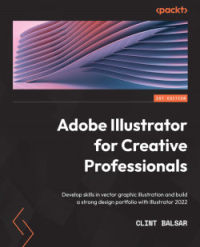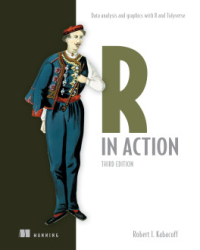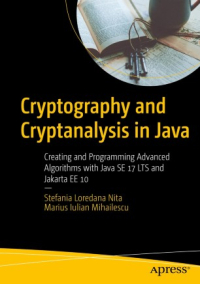Graph eBooks
Mathematics for Game Programming and Computer Graphics
Mathematics is an essential skill when it comes to graphics and game development, particularly if you want to understand the generation of real-time computer graphics and the manipulation of objects and environments in a detailed way. Python, together with Pygame and PyOpenGL, provides you with the opportunity to explore these features under the hood, revealing how computers generate and manipulate 3D environments. Mathematics for Game Programming and Computer Graphics is an exhaustive guide to getting "back to the basics" of mathematics, using a series of problem-based, practical exercises to explore ideas around drawing graphic lines and shapes, applying vectors and vertices, constructing and rendering meshes, and working with vertex shaders. By leveraging Python, Pygame, and PyOpenGL, you'll be able to create your own mathematics-based engine and API that will be used throughout to build applications. By the end of this graphics focussed book, you'll have gained a thorough und ...
Mathematics is an essential skill when it comes to graphics and game development, particularly if you want to understand the generation of real-time computer graphics and the manipulation of objects and environments in a detailed way. Python, together with Pygame and PyOpenGL, provides you with the opportunity to explore these features under the hood, revealing how computers generate and manipulate 3D environments. Mathematics for Game Programming and Computer Graphics is an exhaustive guide to getting "back to the basics" of mathematics, using a series of problem-based, practical exercises to explore ideas around drawing graphic lines and shapes, applying vectors and vertices, constructing and rendering meshes, and working with vertex shaders. By leveraging Python, Pygame, and PyOpenGL, you'll be able to create your own mathematics-based engine and API that will be used throughout to build applications. By the end of this graphics focussed book, you'll have gained a thorough und ...
An Artist's Guide to Programming
An Artist's Guide to Programming teaches computer programming with the aid of 100 example programs, each of which integrates graphical or sound output. The Processing-language-based examples range from drawing a circle and animating bouncing balls to 3D graphics, audio visualization, and interactive games. Readers learn core programming concepts like conditions, loops, arrays, strings and functions, as well as how to use Processing to draw lines, shapes, and 3D objects. They'll learn key computer graphics concepts like manipulating images, animating text, mapping textures onto objects, and working with video. Advanced examples include sound effects and audio visualization, network communication, 3D geometry and animation, simulations of snow and smoke, predator-prey populations, and interactive games. ...
An Artist's Guide to Programming teaches computer programming with the aid of 100 example programs, each of which integrates graphical or sound output. The Processing-language-based examples range from drawing a circle and animating bouncing balls to 3D graphics, audio visualization, and interactive games. Readers learn core programming concepts like conditions, loops, arrays, strings and functions, as well as how to use Processing to draw lines, shapes, and 3D objects. They'll learn key computer graphics concepts like manipulating images, animating text, mapping textures onto objects, and working with video. Advanced examples include sound effects and audio visualization, network communication, 3D geometry and animation, simulations of snow and smoke, predator-prey populations, and interactive games. ...
Exploring Graphs with Elixir
Data is everywhere - it's just not very well connected, which makes it super hard to relate dataset to dataset. Using graphs as the underlying glue, you can readily join data together and create navigation paths across diverse sets of data. Add Elixir, with its awesome power of concurrency, and you'll soon be mastering data networks. Learn how different graph models can be accessed and used from within Elixir and how you can build a robust semantics overlay on top of graph data structures. We'll start from the basics and examine the main graph paradigms. Get ready to embrace the world of connected data! Graphs provide an intuitive and highly flexible means for organizing and querying huge amounts of loosely coupled data items. These data networks, or graphs in math speak, are typically stored and queried using graph databases. Elixir, with its noted support for fault tolerance and concurrency, stands out as a language eminently suited to processing spars ...
Data is everywhere - it's just not very well connected, which makes it super hard to relate dataset to dataset. Using graphs as the underlying glue, you can readily join data together and create navigation paths across diverse sets of data. Add Elixir, with its awesome power of concurrency, and you'll soon be mastering data networks. Learn how different graph models can be accessed and used from within Elixir and how you can build a robust semantics overlay on top of graph data structures. We'll start from the basics and examine the main graph paradigms. Get ready to embrace the world of connected data! Graphs provide an intuitive and highly flexible means for organizing and querying huge amounts of loosely coupled data items. These data networks, or graphs in math speak, are typically stored and queried using graph databases. Elixir, with its noted support for fault tolerance and concurrency, stands out as a language eminently suited to processing spars ...
Secret Key Cryptography
Secret Key Cryptography gives you a toolbox of cryptographic techniques and Secret Key methods. The book's simple, non-technical language is easy to understand and accessible for any reader, even without the advanced mathematics normally required for cryptography. You'll learn how to create and solve ciphers, as well as how to measure their strength. As you go, you'll explore both historic ciphers and groundbreaking new approaches - including a never-before-seen way to implement the uncrackable One-Time Pad algorithm. Whoever you are, this book is for you! History buffs will love seeing the evolution of sophisticated cryptographic methods, hobbyists will get a gentle introduction to cryptography, and engineers and computer scientists will learn the principles of constructing secure ciphers. Even professional cryptographers will find a range of new methods and concepts never published before. From the Roman empire's Caesar cipher to the WWII Enigma machine, secret messages have in ...
Secret Key Cryptography gives you a toolbox of cryptographic techniques and Secret Key methods. The book's simple, non-technical language is easy to understand and accessible for any reader, even without the advanced mathematics normally required for cryptography. You'll learn how to create and solve ciphers, as well as how to measure their strength. As you go, you'll explore both historic ciphers and groundbreaking new approaches - including a never-before-seen way to implement the uncrackable One-Time Pad algorithm. Whoever you are, this book is for you! History buffs will love seeing the evolution of sophisticated cryptographic methods, hobbyists will get a gentle introduction to cryptography, and engineers and computer scientists will learn the principles of constructing secure ciphers. Even professional cryptographers will find a range of new methods and concepts never published before. From the Roman empire's Caesar cipher to the WWII Enigma machine, secret messages have in ...
Full Stack GraphQL Applications
The GraphQL query language radically reduces over-fetching or under-fetching of data by constructing precise graph-based data requests. In Full Stack GraphQL Applications you'll learn how to build graph-aware web applications that take full advantage of GraphQL's amazing efficiency. Neo4j's William Lyon teaches you everything you need to know to design, deploy, and maintain a GraphQL API from scratch. He reveals how you can build your web apps with GraphQL, React, Apollo, and Neo4j Database, aka "the GRANDstack," to get maximum performance out of GraphQL. The GraphQL API query language radically streamlines data exchanges with backend servers by representing application data as easy-to-understand graphs. You can amplify GraphQL's benefits by using graph-aware tools and data stores, like React, Apollo, and Neo4j, throughout your application. A full stack graph approach provides a consistent data model end to end, reducing friction in data fetching and increasing developer prod ...
The GraphQL query language radically reduces over-fetching or under-fetching of data by constructing precise graph-based data requests. In Full Stack GraphQL Applications you'll learn how to build graph-aware web applications that take full advantage of GraphQL's amazing efficiency. Neo4j's William Lyon teaches you everything you need to know to design, deploy, and maintain a GraphQL API from scratch. He reveals how you can build your web apps with GraphQL, React, Apollo, and Neo4j Database, aka "the GRANDstack," to get maximum performance out of GraphQL. The GraphQL API query language radically streamlines data exchanges with backend servers by representing application data as easy-to-understand graphs. You can amplify GraphQL's benefits by using graph-aware tools and data stores, like React, Apollo, and Neo4j, throughout your application. A full stack graph approach provides a consistent data model end to end, reducing friction in data fetching and increasing developer prod ...
Python for ArcGIS Pro
Integrating Python into your day-to-day ArcGIS work is highly recommended when dealing with large amounts of geospatial data. Python for ArcGIS Pro aims to help you get your work done faster, with greater repeatability and higher confidence in your results. Starting from programming basics and building in complexity, two experienced ArcGIS professionals-turned-Python programmers teach you how to incorporate scripting at each step: automating the production of maps for print, managing data between ArcGIS Pro and ArcGIS Online, creating custom script tools for sharing, and then running data analysis and visualization on top of the ArcGIS geospatial library, all using Python. You'll use ArcGIS Pro Notebooks to explore and analyze geospatial data, and write data engineering scripts to manage ongoing data processing and data transfers. This exercise-based book also includes three rich real-world case studies, giving you an opportunity to apply and extend the concepts you studied earli ...
Integrating Python into your day-to-day ArcGIS work is highly recommended when dealing with large amounts of geospatial data. Python for ArcGIS Pro aims to help you get your work done faster, with greater repeatability and higher confidence in your results. Starting from programming basics and building in complexity, two experienced ArcGIS professionals-turned-Python programmers teach you how to incorporate scripting at each step: automating the production of maps for print, managing data between ArcGIS Pro and ArcGIS Online, creating custom script tools for sharing, and then running data analysis and visualization on top of the ArcGIS geospatial library, all using Python. You'll use ArcGIS Pro Notebooks to explore and analyze geospatial data, and write data engineering scripts to manage ongoing data processing and data transfers. This exercise-based book also includes three rich real-world case studies, giving you an opportunity to apply and extend the concepts you studied earli ...
Adobe Illustrator for Creative Professionals
Adobe Illustrator is a vector-based art tool for visual creatives. It is an industry-standard tool that helps you take a design from concept to completion, including the process of peer collaboration and client feedback. Complete with step-by-step explanations of essential concepts and practical examples, you'll begin to build confidence as you master the methods of successful illustrators in the industry by exploring crucial tools and techniques of Adobe Illustrator. You'll learn how to create objects using different tools and methods while assigning varied attributes and appearances. Throughout the book, you'll strengthen your skills in developing structures for maintaining organization as your illustration grows. By the end of this Adobe Illustrator book, you'll have gained the confidence you need to not only create content in the desired format and for the right audience but also build eye-catching vector art based on solid design principles. ...
Adobe Illustrator is a vector-based art tool for visual creatives. It is an industry-standard tool that helps you take a design from concept to completion, including the process of peer collaboration and client feedback. Complete with step-by-step explanations of essential concepts and practical examples, you'll begin to build confidence as you master the methods of successful illustrators in the industry by exploring crucial tools and techniques of Adobe Illustrator. You'll learn how to create objects using different tools and methods while assigning varied attributes and appearances. Throughout the book, you'll strengthen your skills in developing structures for maintaining organization as your illustration grows. By the end of this Adobe Illustrator book, you'll have gained the confidence you need to not only create content in the desired format and for the right audience but also build eye-catching vector art based on solid design principles. ...
R in Action, 3rd Edition
R in Action, 3rd Edition makes learning R quick and easy. That's why thousands of data scientists have chosen this guide to help them master the powerful language. Far from being a dry academic tome, every example you'll encounter in this book is relevant to scientific and business developers, and helps you solve common data challenges. R expert Rob Kabacoff takes you on a crash course in statistics, from dealing with messy and incomplete data to creating stunning visualizations. This revised and expanded third edition contains fresh coverage of the new tidyverse approach to data analysis and R's state-of-the-art graphing capabilities with the ggplot2 package. Used daily by data scientists, researchers, and quants of all types, R is the gold standard for statistical data analysis. This free and open source language includes packages for everything from advanced data visualization to deep learning. Instantly comfortable for mathematically minded users, R easily handles practical prob ...
R in Action, 3rd Edition makes learning R quick and easy. That's why thousands of data scientists have chosen this guide to help them master the powerful language. Far from being a dry academic tome, every example you'll encounter in this book is relevant to scientific and business developers, and helps you solve common data challenges. R expert Rob Kabacoff takes you on a crash course in statistics, from dealing with messy and incomplete data to creating stunning visualizations. This revised and expanded third edition contains fresh coverage of the new tidyverse approach to data analysis and R's state-of-the-art graphing capabilities with the ggplot2 package. Used daily by data scientists, researchers, and quants of all types, R is the gold standard for statistical data analysis. This free and open source language includes packages for everything from advanced data visualization to deep learning. Instantly comfortable for mathematically minded users, R easily handles practical prob ...
Cryptography and Cryptanalysis in Java
Here is your in-depth guide to cryptography and cryptanalysis in Java. This book includes challenging cryptographic solutions that are implemented in Java 17 and Jakarta EE 10. It provides a robust introduction to Java 17's new features and updates, a roadmap for Jakarta EE 10 security mechanisms, a unique presentation of the "hot points" (advantages and disadvantages) from the Java Cryptography Architecture (JCA), and more. The book dives into the classical simple cryptosystems that form the basis of modern cryptography, with fully working solutions (encryption/decryption operations). Pseudo-random generators are discussed as well as real-life implementations. Hash functions are covered along with practical cryptanalysis methods and attacks, asymmetric and symmetric encryption systems, signature and identification schemes. The book wraps up with a presentation of lattice-based cryptography and the NTRU framework library. Modern encryption schemes for cloud and big data environme ...
Here is your in-depth guide to cryptography and cryptanalysis in Java. This book includes challenging cryptographic solutions that are implemented in Java 17 and Jakarta EE 10. It provides a robust introduction to Java 17's new features and updates, a roadmap for Jakarta EE 10 security mechanisms, a unique presentation of the "hot points" (advantages and disadvantages) from the Java Cryptography Architecture (JCA), and more. The book dives into the classical simple cryptosystems that form the basis of modern cryptography, with fully working solutions (encryption/decryption operations). Pseudo-random generators are discussed as well as real-life implementations. Hash functions are covered along with practical cryptanalysis methods and attacks, asymmetric and symmetric encryption systems, signature and identification schemes. The book wraps up with a presentation of lattice-based cryptography and the NTRU framework library. Modern encryption schemes for cloud and big data environme ...
Full Stack Development with Angular and GraphQL
Angular is one of the most popular JavaScript frameworks in modern web app development allowing developers to not only build apps and reuse the code but also develop apps for any deployment target. For web, mobile web, native mobile, and native desktop, GraphQL is the modern and REST alternative for querying web APIs. Using Angular, TypeScript and GraphQL will give you a future-proof and scalable stack you can start building apps around. This book shows you how to build apps using cutting-edge technologies. You'll learn how to solve common web development problems with GraphQL and Apollo, such as database access, authentication, and image uploads. The book starts by introducing you to building full stack apps with Angular and GraphQL. Next, you'll learn how to create a monorepo project with Lerna and NPM Workspaces and configure a Node.js app to use GraphQL with Express and Apollo Server. You'll also understand the basics of Angular architecture and routing. Later, the book demon ...
Angular is one of the most popular JavaScript frameworks in modern web app development allowing developers to not only build apps and reuse the code but also develop apps for any deployment target. For web, mobile web, native mobile, and native desktop, GraphQL is the modern and REST alternative for querying web APIs. Using Angular, TypeScript and GraphQL will give you a future-proof and scalable stack you can start building apps around. This book shows you how to build apps using cutting-edge technologies. You'll learn how to solve common web development problems with GraphQL and Apollo, such as database access, authentication, and image uploads. The book starts by introducing you to building full stack apps with Angular and GraphQL. Next, you'll learn how to create a monorepo project with Lerna and NPM Workspaces and configure a Node.js app to use GraphQL with Express and Apollo Server. You'll also understand the basics of Angular architecture and routing. Later, the book demon ...
Developing Graphics Frameworks with Python and OpenGL
Developing Graphics Frameworks with Python and OpenGL shows you how to create software for rendering complete three-dimensional scenes. The authors explain the foundational theoretical concepts as well as the practical programming techniques that will enable you to create your own animated and interactive computer-generated worlds. You will learn how to combine the power of OpenGL, the most widely adopted cross-platform API for GPU programming, with the accessibility and versatility of the Python programming language. Topics you will explore include generating geometric shapes, transforming objects with matrices, applying image-based textures to surfaces, and lighting your scene. Advanced sections explain how to implement procedurally generated textures, postprocessing effects, and shadow mapping. In addition to the sophisticated graphics framework you will develop throughout this book, with the foundational knowledge you will gain, you will be able to adapt and extend the framework to ...
Developing Graphics Frameworks with Python and OpenGL shows you how to create software for rendering complete three-dimensional scenes. The authors explain the foundational theoretical concepts as well as the practical programming techniques that will enable you to create your own animated and interactive computer-generated worlds. You will learn how to combine the power of OpenGL, the most widely adopted cross-platform API for GPU programming, with the accessibility and versatility of the Python programming language. Topics you will explore include generating geometric shapes, transforming objects with matrices, applying image-based textures to surfaces, and lighting your scene. Advanced sections explain how to implement procedurally generated textures, postprocessing effects, and shadow mapping. In addition to the sophisticated graphics framework you will develop throughout this book, with the foundational knowledge you will gain, you will be able to adapt and extend the framework to ...

